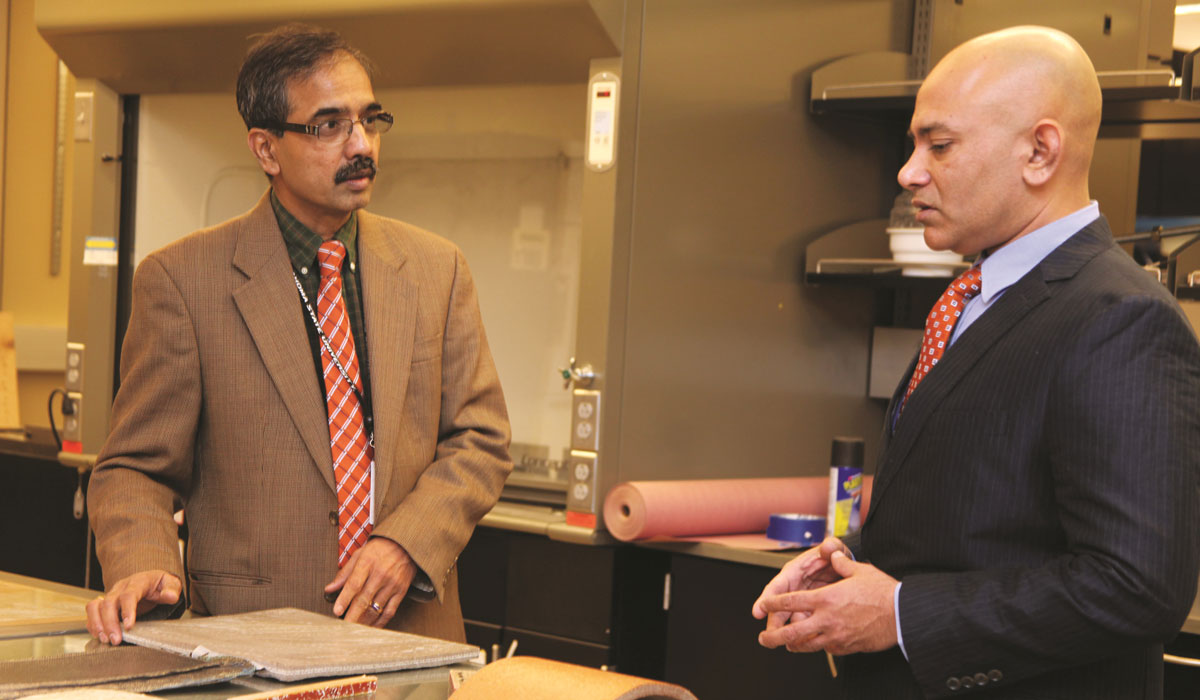Living in Space
Monday, November 9, 2015

Living on the moon could become a reality through new research from engineering and physics faculty at OSU.
“With fewer and fewer places left to explore on Earth, our attention is turning toward outer space,” says Ranji Vaidyanathan, Varnadow Chair and OSU-Tulsa professor of materials science and engineering. “Living in space is the next frontier for us.”
Funded with a $750,000 grant from NASA, an interdisciplinary team is working to develop a new radiation-shielding material that could be used to construct habitats that protect astronauts from prolonged exposure to galactic cosmic radiation.
Vaidyanathan, Raman P. Singh, OSU-Tulsa Helmerich Research Center director, C.F. Colcord Chair and professor of mechanical and aerospace engineering, and Eric Benton, associate professor of physics, are project leaders. Victoria Duca Snowden at the Space Grant Program at the University of Oklahoma is administering the project, assisted by Madeline Baugher at Southwestern Oklahoma State University.
The project, “Radiation Smart Structures and Materials with H-rich Nanostructured Multifunctional Materials,” was one of 15 selected for funding through the NASA Experimental Program to Stimulate Competitive Research (EPSCoR) in 2014.
“OSU is a leader in the development of innovative engineering and aerospace technology,” says OSU-Tulsa President Howard Barnett. “The collaborative project demonstrates how research at the Helmerich Research Center in Tulsa is having an impact on industries across the nation as well as in Oklahoma.”
The material will shield astronauts from ionizing radiation during missions to asteroids near Earth, the moon and Mars and could also be used in the creation of lunar and Martian habitats. Using 3-D printing technology and contour crafting, astronauts will be able to create the parts and construct igloo-like habitats in space, instead of building units on Earth and transporting them.

“Generally, astronauts cannot stay in space for longer than six months because of their prolonged exposure to radiation. After that point, they are at a much higher risk of developing cancer,” says Singh. “The lightweight material we are developing would deflect that radiation and enable space travelers to spend significantly longer amounts of time in space.”
Benton, an expert on radiation shielding, will lead tests on the material to ensure it works under conditions found in outer space. The team will utilize testing facilities in Chiba, Japan, to assess the material’s effectiveness against high-energy particle bombardment.
“The particle accelerator facility we will be using produced the same type of radiation that astronauts are exposed to during space flight without actually being in space,” says Benton. “We have seen promising results from previous studies and are building on those findings with this study.”
The team is collaborating with scientists at NASA Langley Research Center in Virginia, Marshall Space Flight Center in Huntsville, Ala., and Lyndon B. Johnson Space Center in Houston to find additional applications for the material.
NASA EPSCoR establishes partnerships with government, higher education and industry leaders to foster aerospace research opportunities across the country. EPSCoR provides seed money to develop long-term enterprises that will contribute to the country’s economic well-being and advance the aerospace industry.
“The grant will also provide undergraduate students the opportunity to conduct research that could be utilized in a NASA project,” says Vaidyanathan. “These students are exposed to projects they normally would be involved with as graduate researchers, gain invaluable real-world experience and prepare for future research in materials science, aerospace engineering and physics.”
The grant will also fund summer research internships for Oklahoma college students in OSU’s materials science and radiation physics laboratories. The internship programs will target students from minority populations through a partnership with the Louis Stokes Alliance for Minority Participation. Students from two-year partner institutions will be able to apply for the program.
“We hope to create a recruitment pipeline for students interested in engineering who would otherwise not be able to participate in this level of research,” says Singh. “It will enhance their résumés and improve the quality of their education, helping them earn higher salaries when they are ready to join the workforce.”
The project will have a significant impact on the state’s economy as researchers are working with several regional companies to develop the material, including CleanNG LLC, the NORDAM Group of Tulsa and ProCure Proton Therapy Center in Oklahoma City.
For Vaidyanathan, the project is a BHAG — a Big Hairy Audacious Goal — that will push the boundaries of space exploration to places humans have only dreamed about before.
“Human beings have always been explorers. There’s a Viking in all of us,” he says. “We want to be able to go out and explore new things and new ideas. We have dreamed for so long of living in space, so to be able to establish a colony on the moon or Mars would be a great achievement for science and OSU.”
